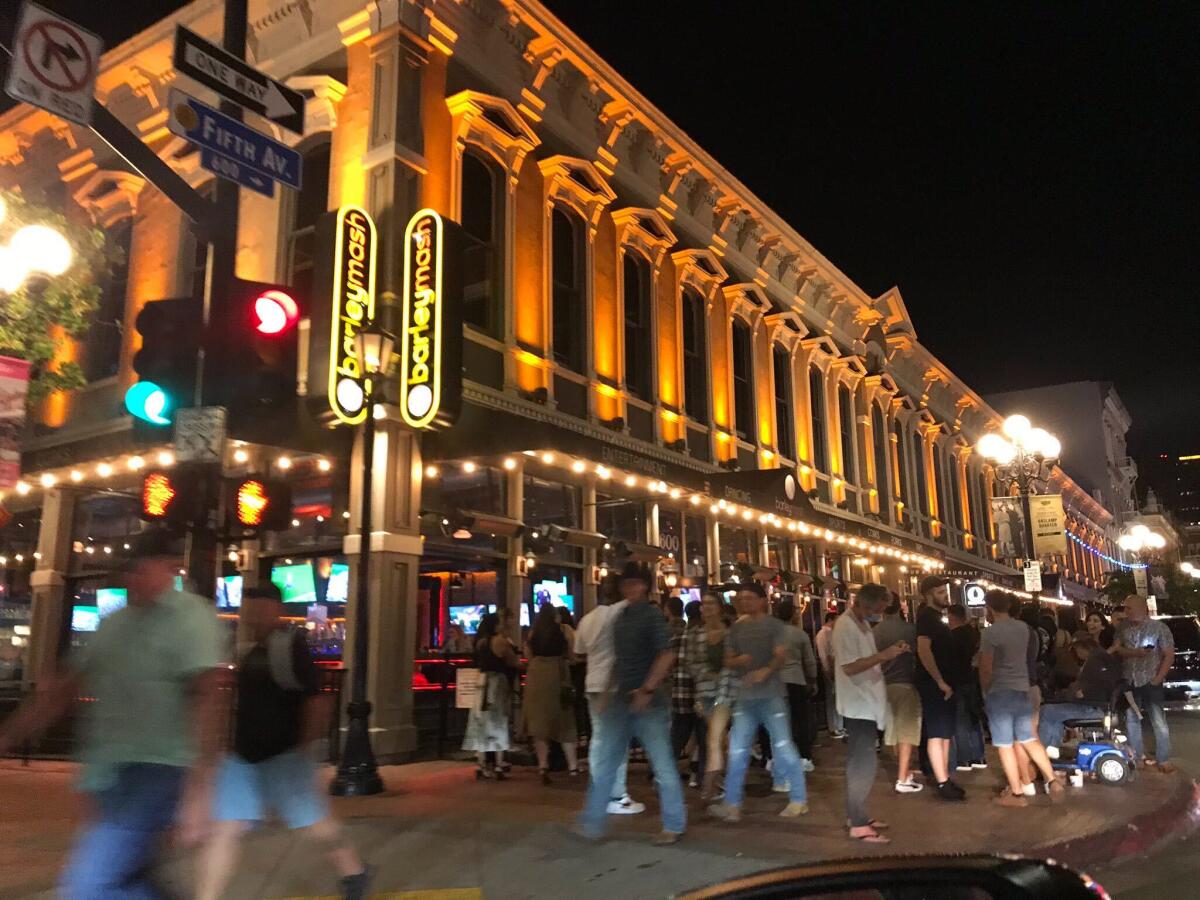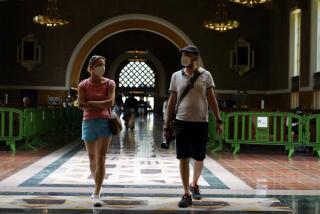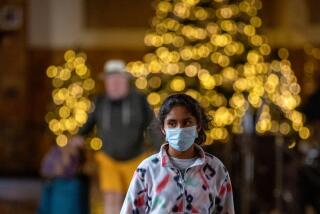Column: Why are so many people not wearing masks? Here’s how they explain it

At lunchtime Tuesday on the sweet, little tree-lined main drag in downtown Glendora, people were out and about under pleasant pandemic skies, and most were not wearing masks.
I’d say it was one-third with, two-thirds without.
I can’t say I was surprised. Even though L.A. County is still seeing more than 1,100 new cases of COVID-19 per day, a lot of people have begun acting as if the pandemic is over. I get that we’re all sick of putting our lives on hold. But as the death toll continues to mount, it’s too soon to abandon basic precautions.
In Los Angeles County, a recent inspection of about 2,000 newly reopened restaurants found that roughly half were out of compliance with safety rules, while in San Diego, a public health warning was issued because of crowds partying mask-free in the Gaslamp District.
On Sunday, I took my dog for a walk at the Eagle Rock Recreation Center and saw 10 sweaty bodies banging into one another on the basketball court while another several hung out waiting to get into the game, and not one mask.
Last week, Orange County’s public health director resigned after her call for mandatory face masks prompted a death threat, a security detail and a poster of her with a Hitler mustache and swastikas. On Tuesday in Santa Ana, face mask supporters were pushed and mocked by foes who chanted, “Hey hey, ho ho, these masks have got to go.”
This, in a country with nearly 117,000 COVID-19 deaths and counting.
In Glendora, some of the people without face coverings were with relatives, and others were carrying masks in their pockets. But it wasn’t hard to find people who told me they didn’t buy into the argument that masks necessarily limit the spread of the coronavirus.
“It’s probably driven by political scare tactics,” said a 77-year-old retiree strolling with his wife, neither of them wearing masks. He added that he didn’t know anyone who has gotten COVID-19, but if reported cases are up, maybe it’s simply because there’s more testing rather than a worrisome surge.
A man named Jon told me that he’s in a bar every night, no one in the place wears a mask, and he doesn’t have a problem with that. He said he lost his job in the cement business because the economy shut down, and while he knows the coronavirus is a killer, he wondered why L.A. County focuses so much on new COVID-19 cases and not on the number of people who recover from the virus.
A woman named Elise came by with a son who was riding a scooter, neither of them wearing a mask. Elise said she doubted that masks do much good.
And then I came upon Robin and her daughter Natasha, both maskless. Robin said she likes to breathe in the fresh air on a nice day, and they cover up in stores, as required. But they weren‘t sold on the usefulness of masks. Natasha said even the Centers for Disease Control and Prevention has contradicted itself on the matter.
No question, there’s still a lot to learn about the virus, and opinions on masks have varied. But for the record, the CDC currently “recommends wearing cloth face coverings in public settings where other social distancing measures are difficult to maintain.”
We implemented safety precautions too late in the U.S., costing lives, and we’ve given up on them too soon, which will cost more. A new University of Washington model forecasts that the COVID-19 death toll could top 200,000 by October.
“Increased mobility and premature relaxation of social distancing led to more infections and we see it in Florida, Arizona, and other states,” said the director of the study. “This means more projected deaths.”
Meanwhile, a new study — published last week by the Proceedings of the National Academy of Sciences — found that face coverings reduced the number of new infections in New York City by 66,000 between April 6 and May 9.
“We conclude that wearing of face masks in public corresponds to the most effective means to prevent inter-human transmission,” said the report, “and this inexpensive practice, in conjunction with extensive testing, quarantine, and contact tracking, poses the most probable fighting opportunity to stop the COVID-19 pandemic, prior to the development of a vaccine.”
There you go. Masks are inexpensive. They are a minor inconvenience. And they are an important part of a strategy to save lives, not to mention that by wearing a mask you let it be known that you care about the health of others.
Somehow the mask requirement became identified as anti-business, when actually the wearing of masks and the observance of other safety measures are what will make reopening possible without a sharp uptick in cases. A little more patience and sacrifice might be the quickest route to greater recovery that benefits everyone.
In California, the number of new cases per day continues to climb. And some states that rushed to return to normal — Arizona turned on the party lights a month ago — are now national hot spots for new cases.
In Tulsa, Okla., public health officials have reported a weekly doubling of COVID-19 hospitalizations, even as they plead with President Trump to cancel a scheduled rally there Saturday at which masks will be provided but not required.
“It’s the perfect storm of potential over-the-top disease transmission,” a Tulsa official told the New York Times.
I can understand how, in a quiet burg like Glendora, where large gatherings don’t happen, it’s easy to be lulled into a false sense of security. I saw lots of kids without masks on the streets, riding bikes and scooters, and wandering around as if this were a normal, disease-free summer.
But it isn’t.
The virus is indeed deadliest in nursing homes and jails, and older people tend to be harder hit, but it knows no boundaries of age or circumstance. The state reported this week that 44% of new cases are in people 34 and younger.
A man named Jack, from Rancho Cucamonga, was playing it safe. He and his wife both wore masks on their visit to Glendora.
“It’s crazy here,” said Jack, bewildered at the resistance to advice from public health officials.
“Eighty percent don’t wear masks here,” said a guy sitting outside a coffee shop with his dog. His mask was on the table, and his wife said they wear masks if they’re in a store or near anyone else. But not everyone is buying in.
“They think it’s a hoax, or they’re Trump supporters,” said a guy named Gary, who sat eight feet away with his mask on the table and his dog at his side.
On Tuesday, the hoax had infected 2.1 million people in the U.S., and the number of fake funerals is now speeding toward 120,000.
Steve.lopez@latimes.com
More to Read
Start your day right
Sign up for Essential California for news, features and recommendations from the L.A. Times and beyond in your inbox six days a week.
You may occasionally receive promotional content from the Los Angeles Times.







